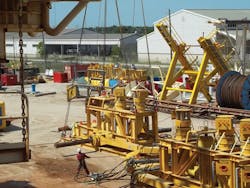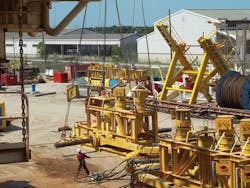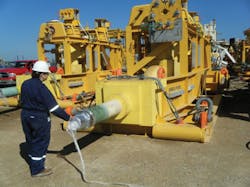Subsea supply chain faces tough revival
Challenges will remain even when market improves
Jessica Cohen
Subsea Engineering Technologies
As the market begins to show early signs of a recovery, contractors and operators are dusting off their shelved plans and looking to re-start and re-evaluate many subsea scopes. EPC contractors, drillers, service companies, engineers all indicate they are ready. But is the full supply chain?
The corporate landscape for subsea hardware supply has changed. Suppliers, like all oil-related companies, have suffered financial loss resulting in waves of lay-offs and company re-structuring. Is it correct to think that manufacturing can easily pick up again and/or re-start? Because order books are now empty, will the unit prices and delivery time be significantly lower? Can we assume the quality of these engineered products will be at the same level as they were pre-downturn?
As 2017 approaches, the market is beginning to stabilize. Industry forecasts show 2017 to be a year of tempered recovery. Early signs of the recovery are indicated by operators revisiting plans for small pipeline and subsea tieback projects. The mantra for all is “we can do this cheaper and better, just let us get started.”
This now brings into focus the subsea component, equipment and tooling suppliers that support the field developments. Over the last two years, these specialist companies have felt the pain. Mergers, acquisitions, financial struggles, and loss of experienced personnel have left many companies significantly downsized and with empty or near-empty order books and associated manufacturing facilities.
As the market moves toward a tempered recovery, how ready are these suppliers to restart manufacturing and supply at a quality akin to pre-downturn levels?
There is a perception that the light will turn from red to green and lead times for delivery and unit prices would surely be significantly shorter and reduced, respectively. First out of the gate, one would think with an empty order book, subsea equipment will be delivered quicker and cheaper than before.
Suppliers who have felt financial struggles over the last two to three years have seen manufacturing facilities slow down, warehouse inventory depleted, sub-suppliers disappear, financing evaporate, and immense lay-off of specialist talent. Additionally, the lack of orders for raw material, forgings, and elastomers in particular for oilfield supply have directed those suppliers to alternate industries to fill the void left by the oil and gas industry. Those alternate industries may not have the same level of quality and technical complexity; to switch back to oilfield supply may involve re-tooling, re-training, and a potential delay in re-start. Key technical people with 10-25+ years of experience have left the industry permanently. Welders, machinists, planners, purchasers, technicians, engineers, inspectors have been laid off. Manufacturing sites may have moved overseas, product lines re-arranged and with that, quality levels could (“will” in our opinion) diminish.
Suppliers have reacted two-fold. First, some will have taken this time to invest in R&D, working on ideas that they have “always wanted to develop” but had no time. Second, they have had to come up with ways to reduce costs, streamline their business model to meet market forces. Operators are requiring cost-efficient ways to produce the same subsea equipment with a focus on reliability and asset integrity. The landscape and business model for the subsea component supply and services has invariably changed from “give me all the bells and whistles” to “Is it field-proven and fit-for-purpose?”
In re-starting the manufacturing of subsea components, there are many hurdles for the purchaser to bear in mind and for the supplier to overcome. These are described below.
The delivery times for manufacturing and testing may be extended as the production process may suffer a new learning curve lag. Procurement of raw materials may actually take longer now than in the past as the raw material suppliers must now re-tool and work oil and gas orders into their existing production lines for other industries. If product lines have been relocated overseas, there is a risk that technical, HSE, and quality drivers could be challenging.
New hires will need to be brought in, with the added expense and time for re-training and getting back up to speed with the process. This includes an impact to quality.
Vendors and warehouse stock of inventory, spares, tooling, and raw materials will have been depleted. Time and organization will be required to bring this back up to pre-downturn levels.
Will the price point be cheaper? New unit prices will have to include a) major start-up overheads, b) concern that this might be a one-off project, c) lag due to learning curve, delay in delivery times, d) financial health of the supplier and sub-suppliers.
The effect on the finished product of poor quality assurance: Is the process still in place and being followed, right person in the right job, verification, qualification?
Qualified sub-suppliers who have previously had a strong relationship with the main supplier may no longer be in business. Sub-suppliers may have been squeezed so much that they have moved into a different industry. With a change in tooling, certification, and training among other factors, switching back to the oilfield supply may not be advantageous or technically capable.
With new market drivers of cost and reliability, the subsea product may need to be re-designed and manufactured with a different process and new qualification programs.
Sales succeed on the good relationship between purchaser and supplier. When the purchaser’s technical sales personnel are no longer with the company, it means the supplier must start again building new relationships, working new interfaces, and dealing with new supply chain personnel whom maybe unfamiliar with the product.
As a purchaser, there are important questions that need to be asked going forward. In an oversight role, one would ask: How has the business model changed? How is quality now assured? Is the ISO certification level still maintained and audited and when last? Does the company have the same experienced personnel? How about training? Has the manufacturing process changed? How about sub-suppliers? How is quality inspection managed? How did the company reduce costs during the downturn? Have these cost reductions impacted quality and technical edge? With cost economies and market forces dictating changing product designs to standardization and possibly modularization, how does this affect functionality, unit cost, delivery lead times, quality, and safety?
Dependent on whether the supply chain has been able to continue operating during this downturn, with a diverse client base, deep pockets and a long-term vision, the notion that once the oil industry recovery is here, the supply of key subsea components can be switched back to full-on manufacturing is an extremely questionable one.
The playing field has definitely changed and while the oil industry is on the brink of interesting times, caution and a healthy level of skepticism should be maintained in re-starting the supply process. The game is definitely not the same from where it left off two years ago.
The author
Jessica Cohen is vice president Construction & Installation Services, Subsea Engineering Technologies.


